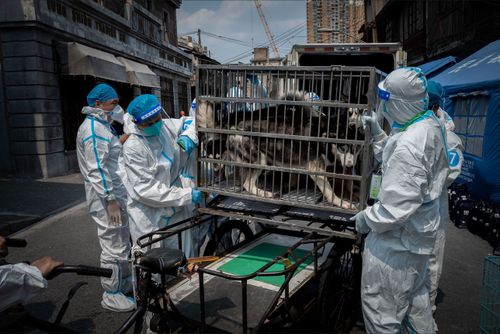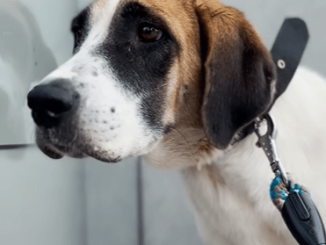
A shocking video of a Rottweiler mauling a two-year-old girl in China has prompted a crackdown by local authorities on stray dogs that some argue has now gone too far.
Authorities were initially praised for their swift response to the incident, but netizens soon began sharing accounts of stray canines in their neighborhood being roughly rounded up and, in some cases, put down.
The new directive to clamp down on large, unleashed dogs is being cited as the latest example of a knee-jerk reaction by Chinese authorities that also highlights the country’s long-standing struggle with animal rights and welfare.
“Just because a large dog bit a child, all of them are being hunted down by ruthless security guards and police,” one user wrote on Chinese social media Weibo under the hashtag “Will the biting of the girl bring stigma to a large dog?” viewed by almost 1 million users.
“Such a one-size-fits-all approach makes me really sad,” she said.
Video of the October 16 attack shows the girl stepping out of a residential compound with her mother in Chongzhou, in China’s southwestern province of Sichuan, and immediately being chased and bitten by a large black Rottweiler.
The mother tries to shield her daughter from the dog, but then tries to pull her back as the animal drags the child around.
A cleaner who comes to help with a broom also fails to drive the dog away.
A man finally succeeds in chasing the Rottweiler away with a wooden stick.
By that time, the mother is sitting on the ground, crying, with her daughter in her arms.

Calls to add Rottweilers to list of banned dogs after string of attacks
The toddler was admitted to hospital, where she was treated for a ruptured kidney, fractured ribs and bite marks on various parts of her body, several Chinese state media outlets reported.
Authorities caught the Rottweiler and detained its owner, according to state media.
Since then, local authorities in a raft of provinces including Shandong, Jiangxi, Yunnan, Hunan, Anhui have stepped up law enforcement, some more heavy-handed than others.
Stray dogs are the main targets, but pets who are unleashed can also be subject to control measures.
Most local police said they would ramp up patrols to round up stray dogs and fine owners who fail to put their dogs on a leash.
More robust approaches include police in Yanzhou in Shandong vowing to hunt down “mad dogs” and euthanize them.

The country is home to 40 million stray dogs, according to the 2021 China Pet Industry white paper.
In the past, strays have been blamed for rabies outbreaks and authorities have attempted to control their numbers with culls.
In one case that triggered an outpouring of grief online, a small stray dog – known as Xiao Huang, or little yellow – was taken away in a net by security personnel at a university campus in Chongqing and beaten to death, according to state-affiliated media.
Many netizens were perplexed by the decision to kill a tiny dog, whose image is being shared on Weibo with the hashtag “straydogxiaohuang,” with a call for greater rights for stray dogs.
The university said the canine had entered the student dormitory, posing a threat to the safety, according to state-affiliated news outlet Beijing Time.
In Shanghai, images of police officers descending on a local neighborhood and dragging away a German Shepherd also sparked fury online.
Many netizens believe the dog was old and did not pose a danger to the community.
But Shanghai authorities said they were acting on complaints from neighbors about an aggressive dog and that it was “taken in and dealt with,” according to a post on their WeChat account.
This is not the first time Chinese authorities have been accused of being heavy-handed with animals.
During Covid, some pet owners complained that their dogs were beaten to death when they were taken away for quarantine, anecdotes that sparked uproar across the internet.
A number of netizens praised the authorities for taking proactive steps, but most warned against the consequences of going overboard.
Celebrities also joined the chorus of animal lovers to call for better understanding.
Chinese actress and singer Cya Liu, who won Best Actress at the Hong Kong Film Awards last year, called for an end to the killing.
“Not all stray dogs are bad just as not all men are good,” she wrote on Weibo, with the hashtag “voicing out for stray dogs.”
Bo Ai Animal Protection Centre Of Guangyuan in Sichuan wrote on Tumblr-like Chinese social media Meipian that China should be using its development to instill a better sense of social responsibility and a respect for animals in people.
“Beating and catching dogs at every turn. Let the world see what our great motherland is like,” it said.
Mother Dog Attempts to Care for Four Tiny Pups Despite Being Left by Owner and Having Both Legs Crushed by a Train

It’s impossible not to weep when you see the tragic predicament of abandoned stray dogs. However, not every mother dog is as courageous, tough, and protective of her children as Si Bao.

After being “mercilessly abandoned” by its owner, this dog was engaged in a tragic accident in which her hind legs were crushed by a train. Si Bao’s life appeared dismal until she gave birth to four very gorgeous and healthy pups, who practically became the driving force in this miserable mother dog’s existence.

After recovering the pleasure of living in life after having children, Si Bao restored her spirit and always kept a resilient and strong attitude to take care of her children. Si Bao walked on two front legs, keeping a watchful eye on the children.

Si Bao’s luck continued to smile when the Jill Robinson-founded nonprofit Animals Asia rescued his family and made this heroic mother dog an animal ambassador. As a consequence, Si Bao has been transferred to the organization’s headquarters, where he may begin a new life with his kid rather than struggling to earn a livelihood off the scraps of food that travelers throw away at the train track. His sole surviving is Muddie.

Furthermore, Si Bao has been renamed Lelly, and she is planning to install wheeled prosthetic legs to allow her to move more freely. Three of Lelly’s four pups died of high fever when the organization found them, leaving just Muddie.

Lelly is currently living the good life as a “Asia animal” ambassador for Animals.

Even though she is just a little dog, Lelly exemplifies an unbreakable character that does not give in to hardship.



Leave a Reply